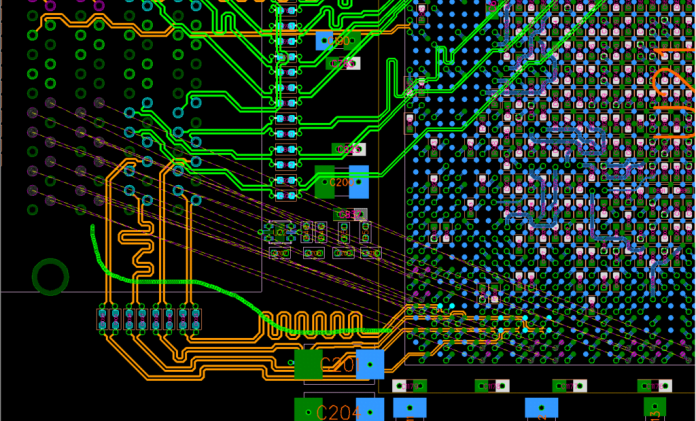A schematic is a visual representation of how a certain device is put together. You can think of it as an instruction manual that contains all the information about which parts to use and how they’re connected.
A schematic contains two main things:
1. The blocks represent the individual components of the circuit
Some examples include resistors, capacitors, inductors, diodes, transistors, and ICs. Each of these blocks has a unique symbol. In the diagrams below, resistors have a rectangular box with a line going through it, capacitors have two parallel lines with a diagonal line going from the top right to bottom left and inductors have a squiggly line with a little diagonal line inside it.
2. The wires between the blocks
Each wire represents a connection between two components. Wires can connect to other wires or to a component block itself. The colors of the wires indicate which wire is connected to which pin on the circuit components. In this diagram, the red wire connects to pin 1 on IC1 to pin 1 on IC2.
Learn how to read a schematic
The very first step to making something with electronics is to learn how to read a schematic. When we say schematic, we don’t mean it in the sense of a blueprint.
What we mean is electrical engineering with diagrams and symbols that show the structure and workings of a device or piece of equipment, and in some cases, how they’re connected together.In order to learn how to read a schematic, you need to use your common sense to relate the symbols to real-world objects.
For example, if there is a round symbol with a line pointing to its right, you know it’s an LED.If there is a symbol that looks like a push-button switch, then that is what it is.
There are plenty of apps available for smartphones that can help you learn how to read a schematic more quickly.
Hint: If you need to know how to read a schematic, check out this article about how to read a schematic, and try out our free online guide to make a walkie talkie circuit. After you have done the circuit once, the next time around should be much easier, so try building it!
Additional resources to help you learn how to read a schematic:
• Use a simulator. Simulators are a great way to test a circuit without having to worry about any of the hardware sides of things. Many of the electronics programs out there have a simulator built in.
• Examine existing schematics. A good place to start if you’re going to be taking apart electronics is to find a schematic for the device you want to dissect. You can find these instruction manuals online on websites like Manualsnet, where you can download them for free.
• Study real schematics. While it’s not realistic to expect you to jump straight from an abstract drawing on a piece of paper to understanding an entirely electronic system, studying a bunch of real schematics will provide a much better overview of what circuits look like and how they work than pure theory ever could.
Key Point: Finding a good schematic, to begin with is the most important thing you can do. Don’t just grab a schematic from a random website and expect it to be useful. A good guide to follow is to see if a schematic has a website that’s associated with it. If it has a website, you can usually review past projects from the designer and see how they created their design
The next step is preparing your workstation
You’re going to want to get an anti-static mat to put your project on so that you don’t ruin your electronics. It also makes it much easier when it comes time to move your project around. The next part is getting your helping hand ready. Your helping hand holds components for you so you don’t have to manually hold them in place while you solder them. It also has a magnifier that will allow you see what you are doing better than just holding it in your hands.
Always keep track of the connections
Every time you make a connection, make sure you draw a line between the parts. This will not only help you keep track of things, but it will also help you while troubleshooting things down the road.
As you create your own ham radio circuits, you need to consider how to connect your circuits together. This is one of the most important aspects of creating a complete ham radio device. There are a few different methods that you can use, depending on what you are creating.
- The first method that you should be aware of when it comes to electronic connections is soldering. Soldering is an excellent way to connect two components because it is not too hard to do, but it is also very effective. When creating electronic circuits or devices, you should always include solder points in your design because they are extremely helpful in the long run.
- The second method for creating connections is using crimp connectors. These connectors are located on both ends of the wire, which makes them much easier to use than other connectors. They are not quite as effective as soldering, but they get the job done well. These connectors make it very easy to attach wires and cables without wasting too much time doing so.
- The last method for connecting your circuits together is with wire nuts. While these may not be the greatest method, they get the job done fairly easily and cheaply. If you’re trying to save money and time with your project, this may be the best option for you. Wire nuts will cap off each end of your wires and cables and then allow them to connect and disconnect with ease.
Complete Control
The bottom line is that even if you don’t have a schematic for a project, you can still figure out how it works by tracing its pins with your finger and connecting them on a board. If you’re taking on a project that involves more than just wiring components together, a schematic will help you see how all the different electronics components interact with each other and will greatly improve your chances of success.





